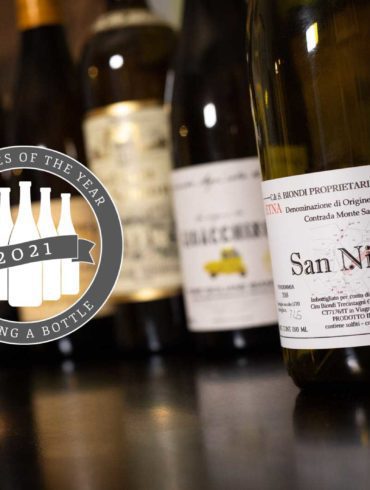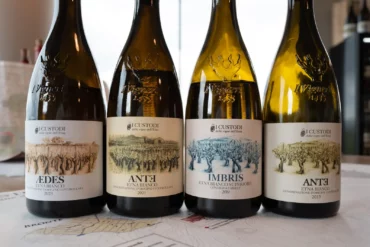Azienda Agricola Biondi

Why Azienda Agricola Biondi is Essential
Ciro Biondi is the coolest cat on Mount Etna. He’s warmly funny, intellectually curious, dapper but never over-dressed, and frequently joined by two enormous, doting bull mastiffs named Lupa and Spotty. Along with his wife, Stef, Biondi presides over a seemingly modest estate on the southeastern slope of Mount Etna. But look a little closer and you'll see that this place has grandeur on an intimate scale.
Planted on neighboring volcanic formations — both formed from ancient Etna eruptions — Chianta, San Nicolo’ and Cisterna Fuori are strikingly beautiful vineyards that require significant toil to manage. The ashy top soil is loose, the pitch is severe, and the wind frequently topples the vines and their chestnut stakes. Yet the wines that come from these hard-scrabble slopes are wonderfully singular, expressive and worthy of long aging.
Biondi's family has tended grapevines for wine production on the slopes of Mount Etna since the 1600s. However, the industry was so in the dumps after World War II, that Ciro’s father, Turi, broke the family’s lineage with winemaking and “got a proper job with the government,” as Biondi put it. He encouraged his son to make a living elsewhere as well, a common story this close to the city of Catania where 20th century urbanization reshaped the landscape. Biondi became an architect, and a particularly talented one at that. But in 1999, the pull of the family's vines called him back. Bit by bit, he and Stef reclaimed the terraces of the family farm and began to make wine. Truly exceptional wine.
While his Etna peers on the north slope burn with ambition, Biondi channels his fervent energy directly into his unique farm. He has used his architectural savvy to remake the historic palmento in the San Nicolo' vineyard into a lavish retreat for guests, and he eyes strips of neighboring land wondering what vines would do there if he extended his Midas touch. “I just can’t stand seeing a piece of land go to waste,” he told me. In Ciro’s head, the wheels are always turning on what could be.
None of this, of course, speaks to his exceptional craft in the cellar. Among his plaudits is none other than Aubert de Villaine of Domaine de la Romanée-Conti, who has visited and offered Biondi his perspective, particularly on the vinification of his Etna Bianco. When Biondi conducted a tasting with me recently — outside under a pergola, as Sicilians prefer — he followed his magnificently structured "Cisterna Fuori” Etna Rosso with his “Pianta” Etna Bianco.
“Why is that?” I asked him.
“You know why, because you've been there. In Burgundy, they always finish with their top white,” he said with a smile.
Trecastagni, Sicily
Grapes: Carricante, Nerello Mascalese, Nerello Cappuccio
Appellations/Cru: Etna Rosso DOC, Etna Bianco DOC
American Importer: Oliver McCrum Wines (West), Selected Estates of Europe (East)
Originally listed: September 2021
Renewed: September 2024
 Winemaker Ciro Biondi in the Chianta vineyard. ©Kevin Day/Opening a Bottle
Winemaker Ciro Biondi in the Chianta vineyard. ©Kevin Day/Opening a Bottle The steep staircase that leads through Biondi's carricante vines in the caldera of the Chianta vineyard. ©Kevin Day/Opening a Bottle
The steep staircase that leads through Biondi's carricante vines in the caldera of the Chianta vineyard. ©Kevin Day/Opening a BottleWines to Seek Out
Azienda Agricola Biondi is one of the smallest producers featured in my curated list of Essential Winemakers of Italy. Production is limited to only about 30,000 bottles per year, which makes these wild and distinctive wines all the more special to seek out.
Biondi makes excellent use of multiple grapes in blending both his red and white wines. The Etna Rosso wines are an 80-20 split between Nerello Mascalese and Nerello Cappuccio. Meanwhile, the Etna Bianco wines are a little richer than those from Etna's star bianco terroir, Milo, due in part to the presence of Minella and Cataratto Bianco, but also the sunnier microclimate.
What I love about these wines is their unmistakable volcanic characteristics, without sacrificing ease of consumption. They are not angular nor stern, nor closed and in need of excess aging. Just vividly alive yet perfectly balanced, refined and massively compelling.
Azienda Agricola Biondi “Outis” Etna Bianco
Etna was the domain of the Cyclops in Homer's The Odyssey. This wine takes its name from Odysseus' epic mic drop reply to the raging monster when he asked “who stabbed my eye out?” As his platoon of men escaped, Odysseus said “Outis,” or “nobody.”
Like Odysseus, this entry-level Etna Bianco is not messing around. It does not aspire to be commercially friendly, or to gently introduce drinkers to the wonders of Carricante from the great smoldering mountain of Sicily. Its aromas dabble in such tertiary tones as iodine and cheese rind (a flirtation of the unknown) while being backed up by strong suggestions of pear and lemon-tea which hold it all together. It's glossy texture and thrilling acidity show Biondi's craft and serve as a superb introduction to the southeastern slope's potential for white wines. Mic drop? Indeed.
Azienda Agricola Biondi “Pianta” Etna Bianco
One of the most beautiful vineyards I've ever walked, Chianta lies mostly inside an ancient caldera above the main farm, with many of its vines climbing vertiginously up the western ridge (see the drone video from Biondi below). Because of confusion with Chianti, the name for this wine was changed to Pianta (Italian for plant) long ago.
This is the wine that Ciro Biondi likes to finish his tastings with. Think of it as a wine with one foot in Sicily and the other foot in the Côtes de Beaune. The nervy energy is directly from that richly volcanic terroir, but it finds its form in the cellar after 24 hours of maceration, barrel fermentation and 9 months of aging in tonneaux barrels, and then rest in stainless steel before bottling. The nose alone is worth the price of admission: pure, intense and suggestive of golden pear, orange peel and spearmint. One of my favorite white wines in all of Italy.
Azienda Agricola Biondi “Outis” Etna Rosso
Biondi makes the case for the south slope's inherent greatness with red wines with his entry-level “Outis" Etna Rosso. But subtly, he also makes the case for Nerello Cappuccio, a frequently abandoned co-plant partner to Nerello Mascalese that accounts for roughly 20% of the Outis blend. What exactly Nerello Cappuccio lends is less important than what it does not obscure: volcanic character and Biondi's incredible sense for precision. I've tasted an “Outis" with 24 years of age to it, and its thumping heart and silky sensations underscored that Etna Rosso can come of age beautifully in the cellar when it comes for a top-tier producer.
Azienda Agricola Biondi San Nicolo’ Etna Rosso
With one look at this vineyard, you know something will be different is the glass. The soil of San Nicolo’ is a rusty reddish color thanks to an increased presence of iron. One third of it scales the side of a rather young, 12,000-year-old volcanic cone named Monte San Nicolo’. The effect is a staircase of rusty earth decorated in orderly vines, and its small size can fool you. When I scaled it one morning for photos, I found the footing to be treacherously loose; this heroic viticulture on an intimate scale.
The red wine that comes from San Nicolo’ is a personal favorite, time and time again. It demonstrates a brilliant little trick: it manages to be restrained with its offerings, yet generous in spirit. You feel like there is more to know from the wine, and so you keep going, but you never feel like it is being coy with its beautifully pure fruit, petrichor-like minimality and ethereal texture.
Azienda Agricola Biondi Cisterna Fuori Etna Rosso
Compared to the San Nicolo’, the Cisterna Fuori single-vineyard Etna Rosso kicks things up a notch significantly. This wine is mysterious and savagely beautiful, with classic Etna Rosso aromas that like to wander into unexpected territory (follow along if you can keep up with this shape-shifter). However, it is the interplay of tart, bitter, sweet, sour, savory and mineral tones on the palate that make it so wonderfully complex and memorable. The tannins mean business, and strongly suggest that you sit down for an indulgent dinner if you are going to proceed any further.














